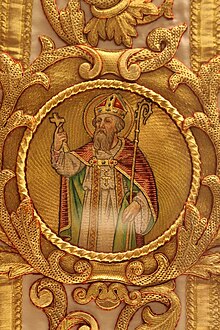Rumbold of Mechelen
| Saint Rumbold | |
|---|---|

Saint Rumbold on a chasuble in the Basilica of Our Lady of Hanswijk, Mechelen
|
|
| Born | possibly Ireland or Scotland |
| Died | 6th, 7th or 8th century (see text) Mechelen |
| Venerated in |
Roman Catholic Church Eastern Orthodox Church |
| Major shrine | St Rumbold's Cathedral in Mechelen |
| Feast | June 24 |
| Attributes | Depicted as a Bishop with a missioner's cross, or a bearded man with a hoe lying under his feet. He may also be shown murdered near a coffer of money. |
| Patronage | Mechelen and Humbeek |
Saint Rumbold (or Rumold, Romuold, Latin: Rumoldus, Dutch: Rombout, French: Rombaut) was an Irish or Scottish Christian missionary, although his true nationality is not known for certain. He was martyred near Mechelen by two men, whom he had denounced for their evil ways.
Saint Rumbold's feast day is celebrated by the Roman Catholic Church, and Western Rite Orthodox Churches, on June 24; and it is celebrated in Ireland on 3 July. He is the patron saint of Mechelen, where St. Rumbold's Cathedral possesses an elaborate golden shrine on its high altar, containing relics attributed to the saint. It is rumoured that his remains are buried inside the cathedral. Twenty-five paintings in the choir illustrate his life.
Rumbold is assumed to have been consecrated a regionary Bishop at Rome. Aodh Buidhe Mac an Bhaird (c. 1590–1635) argued that Rumbold had been born in Ireland. He is also said to have been a Bishop of Dublin, the son of a Scottish king, and the brother of St. Himelin. He is assumed to have worked under St. Willibrord in the Netherlands and Brabant, and also to have been a close companion of the hermit St. Gummarus, and of the preacher monk Fredegand van Deurne, who, according to one tradition, maintained contact with St. Foillan (who was murdered in the Sonian Forest around 665).
...
Wikipedia
